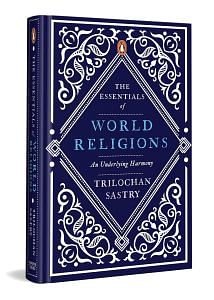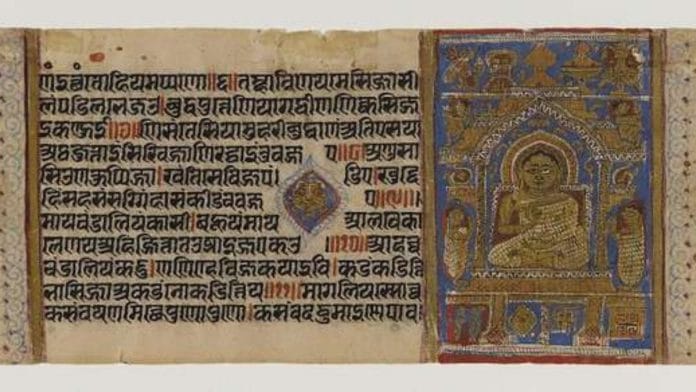Jain philosophy is focused on attaining Nirvana, freedom from the cycle of birth and death. Karma is the basis for being in bondage. Removing all karmas leads to moksha as well as complete enlightenment or Kevala Jnana.
It is based on the ratnatraya or three jewels: right belief, right knowledge and right conduct. They emphasize that right understanding is the first step on the path to liberation. All the important texts of both sects talk of the five or six substances that constitute reality—souls, matter, motion, rest, space and time. It goes on to say that they are eternally real. This implies that there is no creator as creation of anything would imply that it is not eternal. The world also operates according to the law of karma and other laws, which are also always operating.
So there is no need for a creator who governs the universe. In this sense, the twin roles of God as creator and ruler or governor of the universe are not required. Jainism is explicitly atheistic. This is in contrast to all other religions of the world. Buddhism does not either affirm or negate God. Some of the Hindu philosophies also are either silent about God or seem to negate the need for God. Some Hindu philosophies like Nyaya, Vaiseshika and Sankhya say the world always exists, and by implication, there is no need of God.
The Jain concept of the soul is also unique. In Jainism, the soul is eternal but changing. Karma clings to it. The soul evolves over several lives and eventually becomes free. Buddhism, with its own unique concepts, holds that there is no reality called the soul. Hinduism says that the soul is eternal, of the nature of consciousness and unchanging.
The philosophy distinguishes between the Kevala Jnana of the fully enlightened person and the knowledge of others. For an ordinary person, the philosophy of anekantavada applies. The well-known parable of the five blind men and the elephant is given. Each man touches a different part of the elephant and says it is a rope, a pillar, a wall and so on. They have only a partial understanding of reality. Similarly, anekantavada says that all beings can have only a limited or partial view of reality.
Karma is not merely activity, it is a subtle form of matter and envelops the soul. Depending on the activity and the intention, the karma that flows into the jiva can give rise to various fruits like happiness, sorrow, delusion and so on. Activity and intention also determine how thickly karma envelops the soul.
Also read: Aryans got the ‘nakshatra’ system from Harappans in 3000 BC
Jain philosophy is subtle and nuanced. It goes into great detail about the nature of reality. For instance, there are six substances or dravyas that constitute reality, as mentioned earlier. These undergo change and modifications, but do not change in essence. They refer to the soul, matter, space, motion and rest as the five substances that constitute reality.
This is in contrast to some of the Hindu philosophies, which say that anything that is born, and therefore dies and thus changes, is not real in the final analysis. The soul is eternal and does not change even when it apparently goes from one body to another. However, Jain philosophy says the soul is eternal but undergoes changes. Perhaps the issue is how the word ‘jiva’ is translated. In Hindu texts, jiva is the individual, while in Jain texts it is the Atman or soul. In Jainism, the jiva in its purest form is the same as the Hindu Atman—conscious or aware and full of bliss.
There are many souls and each is different from the other, except in its purest form. This is again different from Hinduism. Even Sankhya in Hinduism, which accepts that there are many souls, says they are all identical and unchangeable.
The philosophical texts go deep into the nature of reality. For instance, in Panchastikayasara (the essence of the five existences), the author Kundakunda goes into what a substance is and its qualities. Are they separate from each other or not? If substance is separate, then it can change into many other substances. If the qualities are separate, then there is no need for the substance. It says that we cannot say the following things: that substance and qualities are identical, that they are entirely separate or that they are both distinct and identical. It argues that substance and quality imply both aspects of distinctness and separateness. Similarly, the soul and knowledge cannot be said to be entirely separate.
Jain philosophy has another distinct feature, namely dharma and adharma, which are two of substances of reality. These two words are understood differently in Jainism and in Hinduism. In Hinduism, the etymological meaning of dharma is ‘that which holds, supports and sustains’ the universe. In Jainism, dharma is usually translated as the medium that supports motion.
The Panchastikayasara gives the powerful analogy of water in which fish move to illustrate what dharma means. If we say that the world is always changing, and so in motion, then dharma is that which supports everything. In this interpretation, there is no difference between Jainism and Hinduism—the water is the medium that supports the movement of fish (Jainism), or it is the medium that holds, supports and sustains fish (Hinduism).
Adharma in Hinduism means going against dharma. Clearly, this is not the sense in which adharma is used in Jain philosophy. It means that which gives rest. Anything in motion can also be at rest. Without the principle of rest, anything in motion would never stop. In Jainism, adharma is the principle of rest or that which puts limits on motion.
Since Jainism does not accept God, and accepts the reality of the world, the three obvious aspects—sentient beings, insentient matter and space—are not enough to describe the world. There is a dharma or law according to which living beings and matter function (or move) in space. There is a principle that puts limits on this function or movement, and that is adharma. For theistic religions, dharma and adharma are perhaps taken care of by God who is the Lord of the universe He (or She) created. Jainism’s contribution to philosophy is an explanation of reality without referring to God.
 This excerpt from Trilochan Sastry’s ‘The Essentials of World Religions: An Underlying Harmony’ has been published with the permission of Penguin Random House India.
This excerpt from Trilochan Sastry’s ‘The Essentials of World Religions: An Underlying Harmony’ has been published with the permission of Penguin Random House India.







How can there be a law without a law giver and a law enforcer? God is the law giver and the enforcer. Default nature is lawlessness and chaos. If there was No God there would be no laws.
Universe cannot sustain itself and it is ephermal, it is only 13.7 billion years old.